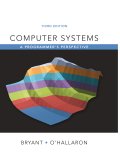
A.
Byte ordering:
- Some machines decide to store the objects in memory ordered from least significant byte to most, while other machines store them from most to least.
- The byte ordering are made by the two ways:
- Little Endian
- In little Endian, the least significant byte comes first.
- Big Endian
- In big Endian, the most significant byte comes first.
- Little Endian
Example:
The example for find the little-endian and big-endian for hexadecimal value is shown below:
Here assume that the hexadecimal value is “0x13244860”. Then address range for given ordering byte is “0x200” through “0x203”.
Big Endian for given hexadecimal value is
| 0x200 | 0x201 | 0x202 | 0x203 |
| 13 | 24 | 48 | 60 |
Little Endian for given hexadecimal value is
| 0x200 | 0x201 | 0x202 | 0x203 |
| 60 | 48 | 24 | 13 |
From the given question, the function definition for “show_bytes” is
void show_bytes(byte_pointer start, size_t len) {
int i;
for (i = 0; i < len; i++)
printf(" %.2x ", start[i]);
printf(“\n”);
}
The function “show_bytes” is used to show the address of a sequence of bytes indicated a byte pointer and a byte length.
B.
Byte ordering:
- Some machines decide to store the objects in memory ordered from least significant byte to most, while other machines store them from most to least.
- The byte ordering are made by the two ways:
- Little Endian
- In little Endian, the least significant byte comes first.
- Big Endian
- In big Endian, the most significant byte comes first.
- Little Endian
Example:
The example for find the little-endian and big-endian for hexadecimal value is shown below:
Here assume that the hexadecimal value is “0x13244860”. Then address range for given ordering byte is “0x200” through “0x203”.
Big Endian for given hexadecimal value is
| 0x200 | 0x201 | 0x202 | 0x203 |
| 13 | 24 | 48 | 60 |
Little Endian for given hexadecimal value is
| 0x200 | 0x201 | 0x202 | 0x203 |
| 60 | 48 | 24 | 13 |
From the given question, the function definition for “show_bytes” is
void show_bytes(byte_pointer start, size_t len) {
int i;
for (i = 0; i < len; i++)
printf(" %.2x ", start[i]);
printf(“\n”);
}
The function “show_bytes” is used to show the address of a sequence of bytes indicated a byte pointer and a byte length.
C.
Byte ordering:
- Some machines decide to store the objects in memory ordered from least significant byte to most, while other machines store them from most to least.
- The byte ordering are made by the two ways:
- Little Endian
- In little Endian, the least significant byte comes first.
- Big Endian
- In big Endian, the most significant byte comes first.
- Little Endian
Example:
The example for find the little-endian and big-endian for hexadecimal value is shown below:
Here assume that the hexadecimal value is “0x13244860”. Then address range for given ordering byte is “0x200” through “0x203”.
Big Endian for given hexadecimal value is
| 0x200 | 0x201 | 0x202 | 0x203 |
| 13 | 24 | 48 | 60 |
Little Endian for given hexadecimal value is
| 0x200 | 0x201 | 0x202 | 0x203 |
| 60 | 48 | 24 | 13 |
From the given question, the function definition for “show_bytes” is
void show_bytes(byte_pointer start, size_t len) {
int i;
for (i = 0; i < len; i++)
printf(" %.2x ", start[i]);
printf(“\n”);
}
The function “show_bytes” is used to show the address of a sequence of bytes indicated a byte pointer and a byte length.
Want to see the full answer?
Check out a sample textbook solution
Chapter 2 Solutions
EBK COMPUTER SYSTEMS
 Computer Networking: A Top-Down Approach (7th Edi...Computer EngineeringISBN:9780133594140Author:James Kurose, Keith RossPublisher:PEARSON
Computer Networking: A Top-Down Approach (7th Edi...Computer EngineeringISBN:9780133594140Author:James Kurose, Keith RossPublisher:PEARSON Computer Organization and Design MIPS Edition, Fi...Computer EngineeringISBN:9780124077263Author:David A. Patterson, John L. HennessyPublisher:Elsevier Science
Computer Organization and Design MIPS Edition, Fi...Computer EngineeringISBN:9780124077263Author:David A. Patterson, John L. HennessyPublisher:Elsevier Science Network+ Guide to Networks (MindTap Course List)Computer EngineeringISBN:9781337569330Author:Jill West, Tamara Dean, Jean AndrewsPublisher:Cengage Learning
Network+ Guide to Networks (MindTap Course List)Computer EngineeringISBN:9781337569330Author:Jill West, Tamara Dean, Jean AndrewsPublisher:Cengage Learning Concepts of Database ManagementComputer EngineeringISBN:9781337093422Author:Joy L. Starks, Philip J. Pratt, Mary Z. LastPublisher:Cengage Learning
Concepts of Database ManagementComputer EngineeringISBN:9781337093422Author:Joy L. Starks, Philip J. Pratt, Mary Z. LastPublisher:Cengage Learning Prelude to ProgrammingComputer EngineeringISBN:9780133750423Author:VENIT, StewartPublisher:Pearson Education
Prelude to ProgrammingComputer EngineeringISBN:9780133750423Author:VENIT, StewartPublisher:Pearson Education Sc Business Data Communications and Networking, T...Computer EngineeringISBN:9781119368830Author:FITZGERALDPublisher:WILEY
Sc Business Data Communications and Networking, T...Computer EngineeringISBN:9781119368830Author:FITZGERALDPublisher:WILEY





